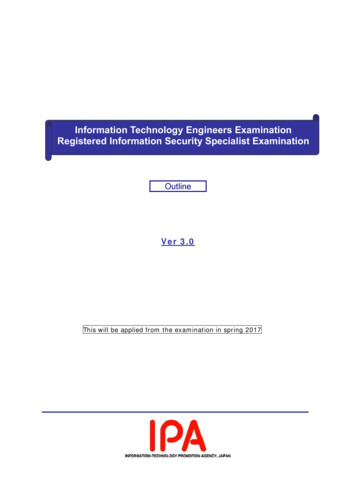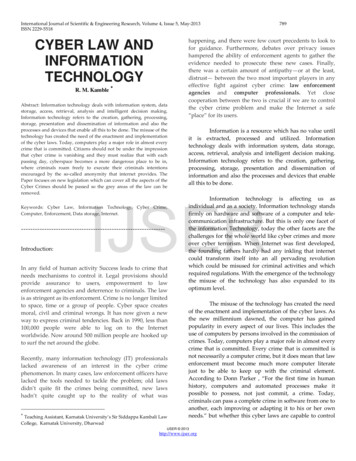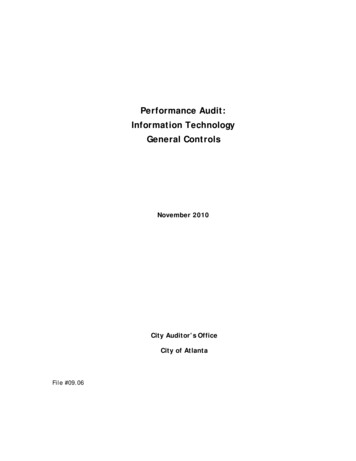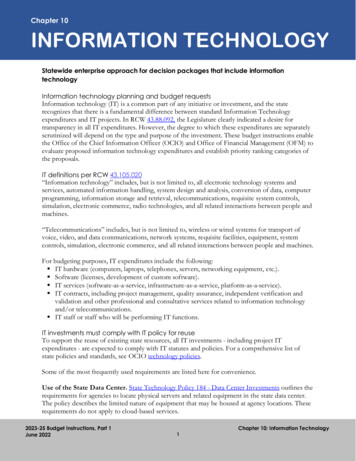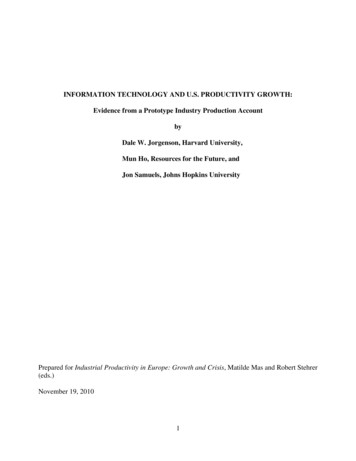
Transcription
INFORMATION TECHNOLOGY AND U.S. PRODUCTIVITY GROWTH:Evidence from a Prototype Industry Production AccountbyDale W. Jorgenson, Harvard University,Mun Ho, Resources for the Future, andJon Samuels, Johns Hopkins UniversityPrepared for Industrial Productivity in Europe: Growth and Crisis, Matilde Mas and Robert Stehrer(eds.)November 19, 20101
NEW DATA ON U.S. PRODUCTIVITY GROWTH BY INDUSTRYbyDale W. Jorgenson, Mun Ho, and Jon Samuels11 IntroductionThe computer equipment manufacturing industry comprised only 0.3 percent of U.S. valueadded from 1960-2007, but generated 2.7 percent of economic growth and 25 percent ofproductivity growth. By comparison, agriculture accounted for 1.8 percent of U.S. value added, butonly 1.0 percent of economic growth during this period. This reflects the fact that agriculture hasgrown more slowly than the U.S. economy, while the computer industry has grown thirteen timesas fast. However, agriculture accounted for fifteen percent of U.S. productivity growth, indicating avery significant role for agricultural innovation.The great preponderance of economic growth in the U.S. involves the replication of existingtechnologies through investment in equipment and software and expansion of the labour force.Replication generates economic growth with no increase in productivity. Productivity growth is thekey economic indicator of innovation. This innovation accounts for less than twelve percent of U.S.economic growth, despite its importance in industries like computers and agriculture. Althoughinnovation contributes only a modest portion of growth, this is vital to long-term gains in theAmerican standard of living.The predominant role of replication of existing technologies in U.S. economic growth iscrucial to the formulation of economic policy. As the U.S. economy recovers from the GreatRecession of 2007-2009, economic policy must focus on maintaining the growth of employmentand reviving investment. Policies that concentrate on enhancing the rate of innovation will have avery modest impact over the intermediate term of ten years. However, the long-run growth of the2
economy depends critically on the performance of a relatively small number of sectors, such asagriculture and computers, where innovation takes place.The purpose of this paper is to present a new data set on U.S. productivity growth byindustry. This data set covers 70 industries for the period 1960-2007 and uses the North AmericanIndustry Classification System (NAICS). Previous industry-level data sets on U.S. productivityprovided by Jorgenson, Gollop, and Fraumeni (1987) and Jorgenson, Ho, and Stiroh (2005) haveused the Standard Industrial Classification (SIC). The U.S. statistical system has shifted graduallyto NAICS, beginning with the Business Census of 1997. The national accounts converted toNAICS in the 2003 Comprehensive Revision of the National Income and Product Accounts.An important advantage of NAICS over the SIC is the greater detail available on the serviceindustries that make up a growing proportion of the U.S. economy. Jorgenson, Ho, Samuels, andStiroh (2007) have shown that U.S. productivity growth has been concentrated in the serviceindustries since 2000, especially those that make intensive use of information technology. NAICSalso provides more detail on industries that produce information technology hardware, software,and services. The IT-service-producing industries, information and data processing services andcomputer systems design and related services, are growing in importance, relative to software andthe IT hardware manufacturing industries – computer and peripheral equipment, communicationsequipment, and semiconductor and other electronic components.This paper begins with a brief summary of the methodology for productivity measurementin Section 2. The traditional approach of Kuznets (1971) and Solow (1970) has been superseded bythe new framework presented in Schreyer’s OECD (2001) manual, Measuring Productivity. Thefocus of productivity measurement has shifted from the economy as a whole to individualindustries like agriculture and computers. The OECD productivity manual has established3
international standards for economy-wide and industry-level productivity measurement. This focusof measuring productivity at the industry level is summarised in Section 3.The OECD standards are based on the production accounts constructed by Jorgenson,Gollop, and Fraumeni (1987). These accounts were updated and revised to incorporate investmentsin information technology hardware and software by Jorgenson, Ho, and Stiroh (2005). The EUKLEMS (capital, labour, energy, materials, and services) study, described by O’Mahony andTimmer (2009), was completed on June 30, 2008. This landmark study presents productivitymeasurements for 25 of the 27 EU members, as well as Australia, Canada, Japan, and Korea, andthe U.S., based on the methodology of Jorgenson, Ho, and Stiroh (2005). Current data for theparticipating countries are available at the EU KLEMS website: http://www.euklems.net/.The hallmark of the new framework for productivity measurement is the concept of capitalservices, including the services provided by IT equipment and software which is dealt with inSection 4. Modern information technology is based on semiconductor technology used incomputers and telecommunications equipment. The economics of information technology beginswith the staggering rates of decline in the prices of IT equipment used for information andcomputing. The “killer application” of the new framework for productivity measurement is theimpact of investment in IT equipment and software on economic growth. Research on the impact ofthis investment is summarised by Jorgenson (2009a) in The Economics of Productivity.Jorgenson, Ho, Samuels, and Stiroh (2007) have traced the American growth resurgenceafter 1995 to sources within individual industries. They have measured output and productivity forthe IT-producing industries and divided the remaining industries between the IT-using industries,those that are particularly intensive in the utilisation of information technology equipment andsoftware, and the Non-IT industries. However, the IT-producing industries were limited to IT4
hardware and software and did not include IT services. Furthermore, the definition of the IT-usingindustries was based on the intensity of IT capital input, relative to total capital input. Again, therole of the IT service industries was not identified. The final section sums up the paper.2 The New Framework for Productivity Measurement.The most serious challenge to the traditional approach to productivity measurement of Kuznets(1971) and Solow (1970) was mounted by Jorgenson and Griliches (1967) in "The Explanation ofProductivity Change". Jorgenson and Griliches departed radically from the measurementconventions of the traditional approach. They replaced Net National Product with GNP as ameasure of output and introduced constant quality indexes for both capital and labour inputs.The key idea underlying the constant quality index of labour input was to distinguish amongdifferent types of labour inputs. Jorgenson and Griliches combined hours worked for each type intoa constant quality index of labour input, using labour compensation per hour as weights in theindex number methodology Griliches (1960) had developed for U.S. agriculture. This considerablybroadened the concept of substitution employed by Solow (1957).While Solow had modelled substitution between capital and labour inputs, Jorgenson andGriliches extended the concept of substitution to include different types of labour inputs as well.This altered, irrevocably, the allocation of economic growth between substitution and productivitygrowth. Constant quality indexes of labour input are discussed detail by Jorgenson, Gollop, andFraumeni (1987, Chapters 3 and 8, pp. 69-108 and 261-300), and Jorgenson, Ho, and Stiroh (2005,Chapter 6, pp. 201-290).Jorgenson and Griliches introduced a constant quality index of capital input bydistinguishing among different types of capital inputs. To combine these capital inputs into a5
constant quality index, they identified prices of the inputs with rental prices, rather than the assetprices used in measuring capital stock used by Solow and Kuznets. This further broadened theconcept of substitution and again altered the allocation of economic growth between substitutionand productivity growth.Jorgenson and Griliches employed a model of capital as a factor of production introducedby Jorgenson (1963) in "Capital Theory and Investment Behaviour". This made it possible toincorporate differences among depreciation rates on different assets, as well as variations in returnsdue to the tax treatment of different types of capital income, into the rental prices. Constant qualityindexes of capital input are presented by Jorgenson, Fraumeni, and Gollop (1987, Chapters 4 and 8,pp. 109-140 and 267-300), and by Jorgenson, Ho, and Stiroh (2005, Chapter 5, pp. 147-200).Finally, Jorgenson and Griliches replaced the aggregate production function employed byKuznets and Solow with the production possibility frontier introduced in Jorgenson (1966) in "TheEmbodiment Hypothesis". This allowed for joint production of consumption and investment goodsfrom capital and labour services. This captures the fact that systems of national accountsdistinguish between outputs of consumption, investment, and other goods and services. Each ofthese is associated with a price deflator specific to the category of output.Jorgenson used the production possibility frontier to generalise Solow's (1960) concept ofembodied technical change, showing that productivity growth could be interpreted, equivalently, as"embodied" in investment or "disembodied". Jorgenson and Griliches (1967) removed thisindeterminacy by introducing constant quality price indexes for investment goods. As a naturalextension of Solow's (1956) one-sector neo-classical model of economic growth, his 1960 model ofembodiment had only a single output and did not allow for the introduction of a separate priceindex for investment goods.6
Oulton (2007) demonstrated that Solow’s model of embodied technical change is a specialcase of Jorgenson’s (1966) model. He also compared the empirical results of Solow’s one-sectormodel and a two-sector model with outputs of consumption and investment goods. Greenwood andKrussell (2007) employed Solow’s one-sector model, replacing constant quality price indexes forinvestment goods with “investment-specific” or embodied technical change. The deflator for thesingle output, consumption, is used to deflate investment, conflicting with national accountingconventions that provide separate deflators for consumption, investment, and other outputs.Jorgenson and Griliches showed that changes in the quality of capital and labour inputs andthe quality of investment goods explained most of the Solow residual. They estimated that capitaland labour inputs accounted for eighty-five percent of growth during the period 1945-1965, whileonly fifteen percent could be attributed to productivity growth. Changes in labour quality explainedthirteen percent of growth, while changes in capital quality another eleven percent.2 Improvementsin the quality of investment goods enhanced the growth of both investment goods output andcapital input, but the net contribution was only two percent of growth.Official Statistics on Productivity.The final blow to the traditional framework for productivity measurement of Kuznets(1971) and Solow (1970) was administered by the Panel to Review Productivity Statistics of theNational Research Council (1979). The Rees Report, Measurement and Interpretation ofProductivity, became the cornerstone of a new measurement framework for the official productivitystatistics. This was implemented by the Bureau of Labour Statistics (BLS), the U.S. governmentagency responsible for these statistics.7
The BLS Office of Productivity and Technology undertook the construction of a productionaccount for the U.S. economy with measures of capital and labour inputs and total factorproductivity, renamed multifactor productivity. A detailed history of the BLS productivitymeasurement program is presented by Dean and Harper (2001). The BLS (1983) framework wasbased on GNP rather than NNP and included a constant quality index of capital input, displacingtwo of the key conventions of the traditional framework of Kuznets and Solow.However, BLS retained hours worked as a measure of labour input until July 11, 1994,when it released a new total factor productivity measure including a constant quality index oflabour input as well. Meanwhile, BEA (1986) had incorporated a constant quality price index forcomputers into the national accounts. This index was included in the BLS measure of output,completing the displacement of the traditional framework of economic measurement by theconventions employed by Jorgenson and Griliches (2007).Jorgenson and Landefeld (2006) have developed a new architecture for the U.S. nationalincome and product accounts (NIPAs) that includes prices and quantities of capital services for allproductive assets in the U.S. economy, as well as productivity. The incorporation of the price andquantity of capital services into the United Nations’ System of National Accounts 2008 (2009) wasapproved by the United Nations Statistical Commission at its February-March 2007 meeting.Schreyer, then head of national accounts at the OECD, prepared an OECD Manual, MeasuringCapital, published in 2009. This provides detailed recommendations on methods for theconstruction of prices and quantities of capital services.In Chapter 20 of SNA 2008 (U.N. 2009, page 415), estimates of capital services aredescribed as follows: “By associating these estimates with the standard breakdown of value added,the contribution of labour and capital to production can be portrayed in a form ready for use in the8
analysis of productivity in a way entirely consistent with the accounts of the System.” Themeasures of capital and labour inputs and productivity in the prototype system of U.S. nationalaccounts presented by Jorgenson and Landefeld (2006) and updated by Jorgenson (2009b) areconsistent with the OECD productivity manual, SNA 2008, and the OECD Manual, MeasuringCapital. The volume measure of input is a quantity index of capital and labour services, while thevolume measure of output is a quantity index of investment and consumption goods. Productivity isthe ratio of output to input.The new architecture for the U.S. national accounts was endorsed by the Advisory Committee onMeasuring Innovation in the 21st Century Economy to U.S. Secretary of Commerce (2008, page 8)Guttierez:The proposed new ‘architecture’ for the NIPAs would consist of a set of income statements,balance sheets, flow of funds statements, and productivity estimates for the entire economyand by sector that are more accurate and internally consistent. The new architecture willmake the NIPAs much more relevant to today’s technology-driven and globalising economyand will facilitate the publication of much more detailed and reliable estimates ofinnovation’s contribution to productivity growth.In response to the Advisory Committee’s recommendations, BEA and BLS have producedan initial set of total factor productivity estimates integrated with the NIPAs. The results arereported by Harper, Moulton, Rosenthal, and Wasshausen (2009) and will be updated annually.This is a critical step in implementing the new architecture. Estimates of productivity are essentialfor projecting the potential growth of the U.S. economy, as demonstrated by Jorgenson, Ho, andStiroh (2008). The omission of productivity statistics from the NIPAs and the 1993 SNA has been aserious barrier to assessing potential growth.9
3 Measuring Productivity at the Industry Level.A complete system of industry-level production accounts for the U.S. economy was constructed byGollop and Jorgenson (1980) and Jorgenson, Gollop, and Fraumeni (1987), using the SIC. Thesystem incorporates a consistent time series of input-output tables and provides the basis for theindustry-level production accounts presented by Schreyer’s OECD Productivity Manual (2001).Details on the construction of the time series of input-output tables are presented by Jorgenson,Gollop, and Fraumeni (1987, Chapter 5, pp. 149-182) and Jorgenson, Ho, and Stiroh (2005,Chapter 4, pp. 87-146).The approach to growth accounting presented by Jorgenson, Gollop and Fraumeni (1987)and the official statistics on aggregate productivity published by the BLS in 1994 have beenrecognised as the international standard. This standard is discussed in Schreyer’s (2001) OECDManual, Measuring Productivity. The expert advisory group for this Manual was chaired by Dean,former Associate Commissioner for Productivity at the BLS and a leader of the successful effort toimplement the Rees Report (1979).Reflecting the international consensus on productivity measurement, the AdvisoryCommittee on Measuring Innovation in the 21st Century Economy to the U.S. Secretary ofCommerce (2008, page 7) recommended that the Bureau of Economic Analysis (BEA) should:Develop annual, industry-level measures of total factor productivity by restructuring theNIPAs to create a more complete and consistent set of accounts integrated with data fromother statistical agencies to allow for the consistent estimation of the contribution ofinnovation to economic growth.The principles for constructing industry-level production accounts are discussed by Fraumeni,Harper, Powers, and Yuskavage (2006). Disaggregating the production account by industrial10
sector requires the fully integrated system of input-output accounts and accounts for gross productoriginating by industry, described by Lawson, Moyer, Okubo and Planting (2006), and Moyer,Reinsdorf, and Yuskavage (2006). Donahoe, Morgan, Muck, and Stewart (2010) present data forthe fully integrated system for 1998-2008 on a NAICS basis.Jorgenson, Ho, and Stiroh (2005), the EU KLEMS project described by O’Mahony andTimmer (2009), and the studies presented in Jorgenson (2009a), The Economics of Productivity,present industry-level data on productivity. These data have made possible the internationalcomparisons of patterns of structural change presented by Jorgenson and Timmer (2009). Effortsare underway to extend the EU KLEMS framework to important developing and transitioneconomies, including Argentina, Brazil, Chile, China, India, Indonesia, Mexico, Russia, Turkey,and Taiwan. This project may be followed at www.worldklems.net.4 Economic Impact of Information TechnologyWe provide NAICS-based estimates of output and productivity for the IT-producing industrieslisted in Table 1. These include software and the IT-services industries – information and dataprocessing and computer systems design – as well as the IT-producing hardware industries –computers, communications equipment, and semiconductors. The information and data processingindustry provides computation, communications, and storage services that compete directly withthe services provided through investment in IT equipment and software. The computer systemsdesign industry provides the services necessary to integrate this investment into businessoperations.In our earlier work using the SIC (Jorgenson, Ho and Stiroh 2005, Jorgenson et al 2007), wehave defined IT intensity at the industry level as the share of IT-capital input in total capital input11
of that industry. The NAICS data here introduces a level of detail not seen in the SIC system –intermediate inputs from the IT-service producers. Let AIT , j denote these intermediate purchases byindustry j, and define the IT-intensity index as the share of capital input coming from IT-capital andthese IT-services:(1)III j K ITjT AIT , j ,TK jT AIT , j ,T; T 20053where K ITjT is the IT-capital input and K jT is the total capital input .These intensities are given in Tables 1 and 2. We define the IT-using industries as thosewith III more than the median share of 15.4 percent in 2005 which are listed in Table 1. Theseinclude Wholesale and Retail Trade as well as many of the major service industries. The Non-ITindustries are given in Table 2 and include the resource-based industries, agriculture and mining, aswell as many of the major manufacturing industries. We present NAICS-based estimates of outputand productivity for these industries as well.We initially focus on the IT-producing sectors. The distinctive feature of IT equipment andsoftware is the swift decline in prices. Figure 1 shows that computers and semiconductors have hadrapidly defining prices, relative to the GDP deflator, since the commercialisation of the electroniccomputer in 1959. The decline accelerated with the switch from vacuum tubes to semiconductorsaround 1970. Software publishing has had a rapid rate of decline from the same time, but thisslowed after 1990. The IT-services sectors have had declining prices, relative to the GDP deflator,only since 2000.Jorgenson (2001) has shown that the acceleration in the rate of decline of the prices ofcomputers and semiconductors around 1995 is the source of the investment boom in IT hardwareand software during the period 1995-2000. He attributed the acceleration in the price decline of12
computers and semiconductors to a shift in the product cycle for semiconductors from three yearsto two years. We note that the rate of decline of semiconductor prices has slowed since 2000, whilethe accelerated decline in computer prices that began in 1995 has continued.Figure 2 presents the shares of IT-producing industries in the U.S. GDP on an annual basissince 1960. The overall share has increased substantially from around one percent of the GDP tojust under three percent at the end of the period 1960-2007. However, the IT investment boom of1995-2000 can now be identified as an unsustainable “bubble” that burst in 2000. The share of ITsoftware and hardware – computers, semiconductors, and telecommunications equipment hasdropped substantially since 2000 and shows no signs of revival. The IT service industries,especially computer systems design, grew substantially during the IT investment boom of the1990’s and have resumed the growth that was interrupted by the dot-com crash of 2000.We define the contribution of an industry to U.S. economic growth as the growth rate ofreal value added in the industry, weighted by the share of the industry in the GDP. Figure 3 givesthe contributions of the six IT-producing sectors to economic growth during the period 1960-2007.Computers, semiconductors, and software have grown at double-digit rates throughout this period.The contributions of these industries to U.S. economic growth were far out of proportion to theirrelatively modest shares in value added. The technology employed in communications equipmenthas some affinities with computer technology, but the growth rate of this industry is much belowthat of computers and its contribution to economic growth is relatively modest.The contributions of IT hardware and software peaked during the IT investment boom from1995-2000, but these contributions did not prove to be sustainable and have fallen below theaverage contributions of 1960-1995. Software contribution remains a bit above the average of theearlier period, but the contribution of semiconductors is considerably below. The contribution of13
computer systems design also peaked during the boom, but this contribution is well above the1960-1995 average. The contribution of information and data processing has grown steadilythroughout the period 1960-2007.The price of an asset is transformed into the price of the corresponding capital input by anannualisation factor known as the cost of capital. The cost of capital includes the nominal rate ofreturn, the rate of depreciation, and the rate of capital loss due to declining prices. The distinctivecharacteristics of IT prices – high rates of price decline and rates of depreciation – imply that costof capital for the price of IT capital input is very large relative to the cost of capital for the price ofNon-IT capital input.The prices of capital inputs are essential for assessing the contribution of investment in ITequipment and software to economic growth. This contribution is the relative share of ITequipment and software capital input in the value of aggregate output, multiplied by the rate ofgrowth of IT capital inputs. A substantial part of the growing contribution of capital input in theU.S. can be traced to the change in composition of investment associated with the growingimportance of IT equipment and software.The contributions of college-educated and non-college-educated workers to U.S. economicgrowth is given by the relative shares of these workers in the value of output, multiplied by thegrowth rates of their hours worked. Personnel with a college degree or higher level of educationcorrespond closely with “knowledge workers” who deal with information. Of course, not everyknowledge worker is college-educated and not every college graduate is a knowledge worker.Productivity growth is the key economic indicator of innovation. Economic growth can takeplace without innovation through replication of established technologies. Investment increases theavailability of these technologies, while the labour force expands as population grows. With only14
replication and without innovation, output will increase in proportion to capital and labour inputs.By contrast the successful introduction of new products and new or altered processes, organisationstructures, systems, and business models generates growth of output that exceeds the growth ofcapital and labour inputs. This results in growth in total factor productivity or output per unit ofinput.Innovation is often described as the predominant source of economic growth. This finding iscalled “Solow’s surprise” by Easterly (2001) and is listed as one of the “stylised facts” abouteconomic growth by King and Rebelo (1999). However, Table 3 shows that the growth ofproductivity was far less important than the contributions of capital and labour inputs. For theperiod 1960-2007, productivity accounts for less than twelve percent of U.S. economic growth,slightly less than the fifteen percent of growth for 1945-1965 estimated by Jorgenson and Griliches(1967). The contribution of capital input accounts for 60 percent of growth during the period 19602007, while labour input accounts for 28 percent.The great preponderance of U.S. economic growth is due to replication of establishedtechnologies rather than innovation. This is despite the fact that growth in industries like agricultureand computers is due mainly to innovation. Innovation is obviously far more challenging andsubject to much greater risk. The diffusion of successful innovation requires mammoth financialcommitments. These fund the investments that replace outdated products and processes andestablish new organisation structures, systems, and business models. Although innovation accountsfor a relatively minor portion of economic growth, this portion is vital for maintaining gains in theU.S. standard of living in the long run.Turning to the sources of the U.S. growth acceleration after 1995, Table 3 (second lastcolumn) shows that IT capital input was by far the most significant. Growth increased by 1.1015
percent in 1995-2000, while the contribution of IT capital input increased by 0.61 percent. Manyindustries substituted IT equipment and software for Non-IT investment, leading to a decline in thecontribution of Non-IT investment to growth. The increased contribution of labour input in 19952000 was almost evenly divided between college and non-college workers in this period ofunusually low unemployment. The pace of innovation clearly accelerated during the IT investmentboom and the contribution of productivity to the acceleration of U.S. economic growth was slightlyabove the contribution of IT investment, 0.62 versus 0.61 percentage points.Jorgenson, Ho, and Stiroh (2008) have shown that the rapid pace of U.S. economic growthafter 1995 was not sustainable. After the dot-com crash in 2000 the overall growth rate dropped towell below the long-term average of 1960-1995. The contribution of investment also declinedbelow the 1960-1995 average, but the shift from Non-IT to IT capital input continued. Thecontribution of labour input dropped precipitously, accounting for most of the decline in economicgrowth during the “jobless” recovery that followed. The contribution to growth by college-educatedworkers continued at a reduced rate, but that of non-college workers was negative.The most remarkable feature of the recovery after 2000 was the continued growth ofproductivity, indicating a renewed surge of innovation. In order to analyze this in more detail, weutilise the production possibility frontier of Jorgenson, Gollop, and Fraumeni (1987, Ch. 9, pp. 301342) and Jorgenson, Ho, and Stiroh (2005, Ch. 8, pp. 361-416). This gives the relationship betweenaggregate productivity growth and productivity growth at the industry level. The growth rate ofaggregate productivity includes a weighted average of industry productivity growth rates, using aningenious weighting scheme originated by Domar (1961). In the Domar weighting scheme theproductivity growth rate of each industry is weighted by the ratio of the industry’s gross output toaggregate value added. A distinctive feature of Domar weights is that they sum to more than one,16
reflecting the fact that an increase in the rate of growth of the industry’s productivity has twoeffects. The first is a direct effect on the industry’s output and the second an indirect effect via theoutput delivered to other industries as intermediate inputs.The rate of growth of aggrega
The purpose of this paper is to present a new data set on U.S. productivity growth by industry. This data set covers 70 industries for the period 1960-2007 and uses the North American Industry Classification System (NAICS). Previous industry-level data sets on U.S. productivity

